HOW TO READ TYRE SIZE AND OTHER SPECIFICATIONS
Tyre have a code system moulded into their sidewall which allows you to understand their technical capabilities. This code provides information on tyre size, construction (e.g. radial), its load-carrying capacity and its speed rating.
For example:
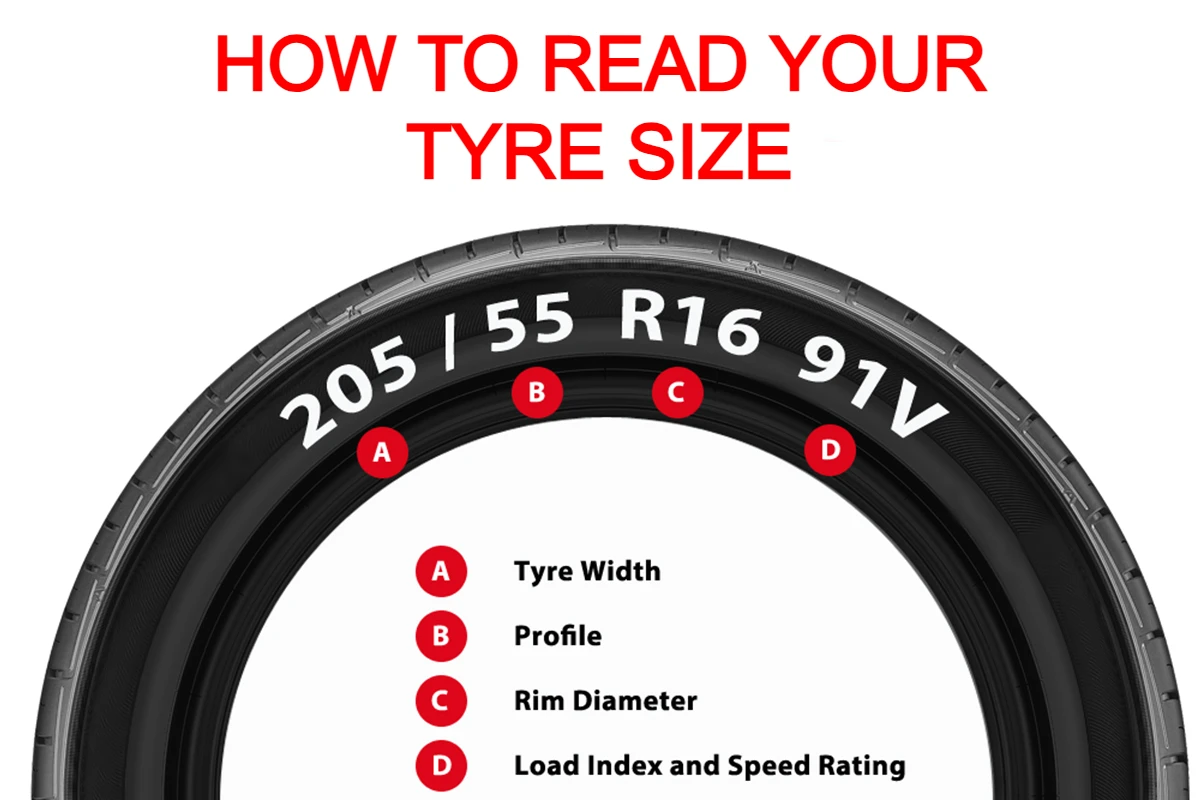
- 205 indicates the nominal section width of the tyre in millimetres (195mm).
- 55 indicates its aspect ratio, a comparison of the tyre’s section height with its section width (55 indicates the height is 55% of its width).
- R indicates radial ply construction.
- 16 indicates the nominal diameter of the wheel rim (16 inches).
- 91V is a symbol indicating the maximum load capacity and speed at which the tyre can be safely operated, subject to the tyre being in sound condition, correctly fitted, and with recommended inflation pressures (91 represents a maximum load of 615 kg per tyre; V represents a maximum speed of 240km/h).
WHAT IS TYRE

A tyre is a ring-shaped component that surrounds a wheel’s rim to transfer a vehicle’s load from the axle through the wheel to the ground and to provide traction on the surface traveled over. Most tires, such as those for automobiles and bicycles, are pneumatically inflated structures.
The materials of modern pneumatic tires are synthetic rubber, natural rubber, fabric and wire, along with carbon black and other chemical compounds. They consist of a tread and a body. The tread provides traction while the body provides containment for a quantity of compressed air.
Pneumatic tires are used on many types of vehicles, including cars, bicycles, motorcycles, buses, trucks, heavy equipment, and aircraft. Metal tires are still used on locomotives and railcars, and solid rubber (or other polymer) tires are still used in various non-automotive applications, such as some casters, carts, lawnmowers, and wheelbarrows.
Components
A Tyre comprises several components: the tread, bead, sidewall, shoulder, and ply.
Tread
The tread is the part of the Tyre that comes in contact with the road surface, also known as the crown. The portion that is in contact with the road at a given instant in time is the contact patch. The tread is a thick rubber, or rubber/composite compound formulated to provide an appropriate level of traction that does not wear away too quickly
Bead
The Tyre bead is the part of the Tyre that contacts the rim on the wheel. The bead is typically reinforced with steel wire and compounded of high strength, low flexibility rubber. The bead seats tightly against the two rims on the wheel to ensure that a tubeless Tyre holds air without leakage.
Sidewall
The sidewall is that part of the Tyre, or bicycle Tyre, that bridges between the tread and bead. The sidewall is largely rubber but reinforced with fabric or steel cords that provide for tensile strength and flexibility. The sidewall contains air pressure and transmits the torque applied by the drive axle to the tread to create traction but supports little of the weight of the vehicle, as is clear from the total collapse of the Tyre when punctured.
Shoulder
The shoulder is the area where the tread and sidewall meet, including the tread blocks nearest the side of the tire (beginning outside the outermost water channel) and the area transitioning to the side of the tire where tread grooves are still visible.
PLY
Plies are layers of relatively inextensible cords embedded in the rubber` to hold its shape by preventing the rubber from stretching in response to the internal pressure.
Tyre Structure
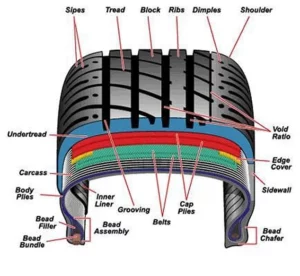
WHEEL
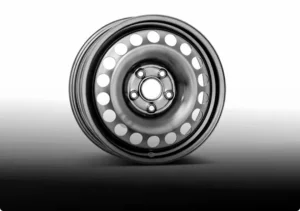
Associated components of a Tyres, includes the wheel on which it is mounted, the valve stem through which air is introduced, and, for some Tyres, an inner tube that provides the airtight means for maintaining Tyre pressure.
Wheel—Pneumatic Tyres are mounted onto wheels that most often have integral rims on their outer edges to hold the Tyre. Automotive wheels are typically made from pressed and welded steel, or a composite of lightweight metal alloys, such as aluminum or magnesium.
Valve stem—Pneumatic Tyres receive their air through a valve stem—a tube made of metal or rubber, with a check valve, typically a Schrader valve on automobiles and most bicycle Tyres
Inner tube—Most bicycle Tyres, many motorcycle Tyres, and many Tyres for large vehicles such as buses, heavy trucks, and tractors are designed for use with inner tubes
Classification of Tyres
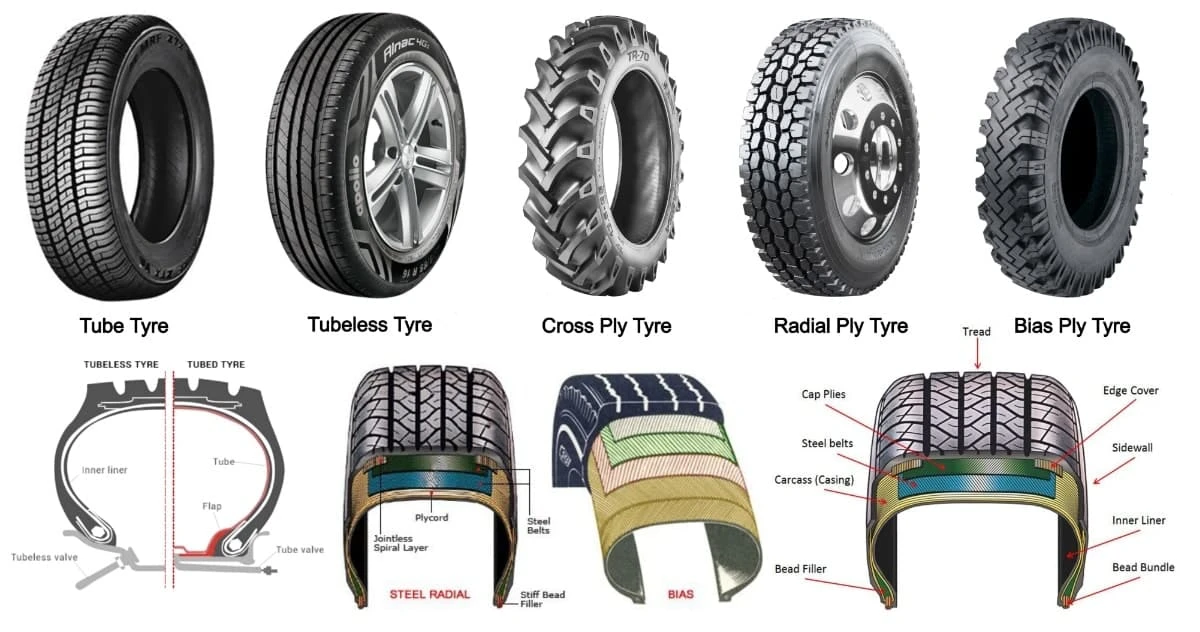
Tyres can be classified on the basis of the following parameters:
Based on application: Passenger car tyres, LCV tyres, HDV tyres, two-wheeler tyres, three-wheeler tyres, tractor tyres, etc.
Based on type of construction: Bias ply construction or radial construction.
Based on carcass material.
Based on pattern design.
Tyre Categories

All Terrain
All-terrain (A/T) tyres are recommended for vehicles that travel on both tarmac roads as well as off-road use. They are more durable for cross country and allow better control of the vehicle on varying surfaces. However, they are more expensive than standard tyres and produce more rolling noise.
Off Road/Mud Terrain
Off-road tires (Off-road tyre) are a category of vehicle tires that use deep tread to provide more traction on unpaved surfaces such as loose dirt, mud, sand, or gravel.[1]Compared to ice or snow tires, they lack studs but contain deeper and wider grooves meant to help the tread sink into mud or gravel surfaces.
Paddle Tyres
Paddle tyres are mainly used on off road vehicles, specifically designed for use in sand and mud. They consist of a smooth tire core which has a series of large rubber cups (or paddles) attached to it. The volume inside of a paddle is much larger than the void of a knobby tyre, so it is unlikely to clog up with sand/mud. A street legal mud tyre is a more or less normal tire, but with extra large gaps or “voids” between each tread block (called “lugs”) to allow centrifugal force to “self-clean” or fling the mud out of the gap. Smaller gaps trap the mud in between the tire lugs, which turns the tire into something resembling a “slick” with no tread at all, which will have no traction in mud.
All Season
A tyre designed to have long tread life in warm conditions, with rubber that remains soft down to freezing weather, for good performance in three seasons and passable performance in winter
Summer
A tyre designed to have long tread life in warm conditions, that will maintain grip in wet and dry conditions, and will function in hot and cool weather, but does not maintain grip in cold or freezing conditions
Winter
Winter tires—are tires designed for use on snow and ice. Snow tires have a tread design with larger gaps than those on summer tires, increasing traction on snow and ice. Such tires that have passed a specific winter traction performance test are entitled to display a “Three-Peak Mountain Snow Flake” symbol on their sidewalls. Tires designed for winter conditions are optimized to drive at temperatures below 7 °C (45 °F). Some snow tires have metal or ceramic studs that protrude from the tire to increase traction on hard-packed snow or ice.
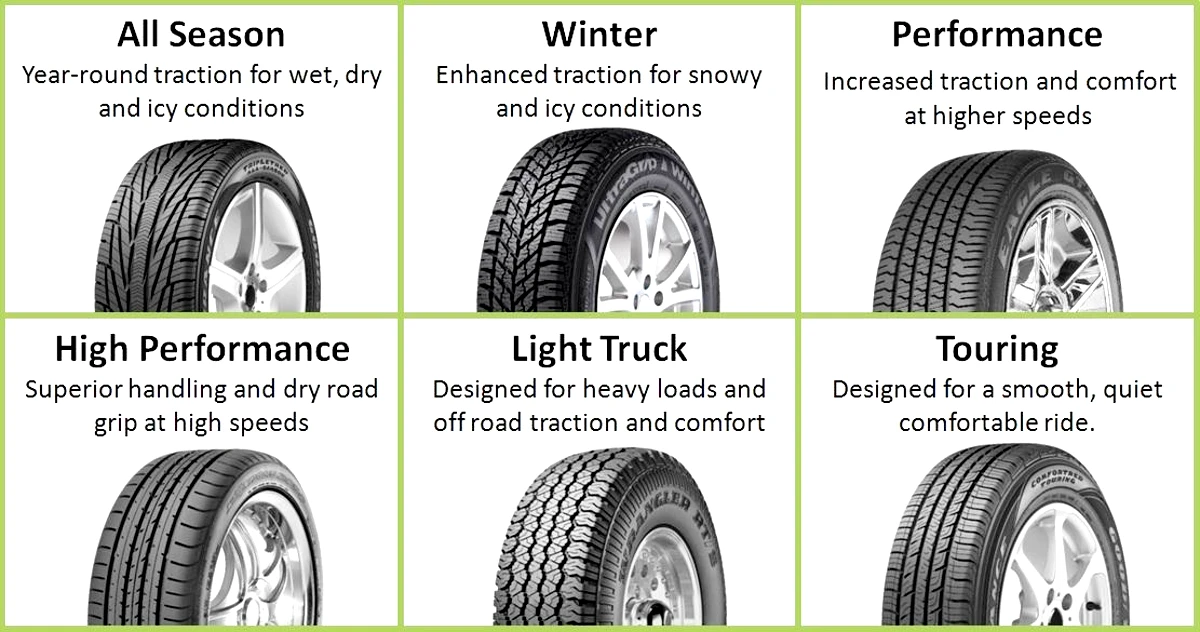
TYRESIZE.IN PROVIDES YOU INFO ABOUT TYRESIZE AND OTHER SPECIFICATIONS.
Tyres as being as important as the engine or the brakes, perhaps. But if you don’t take care of your tyres, your bike’s handling, performance and fuel efficiency will be severely affected.